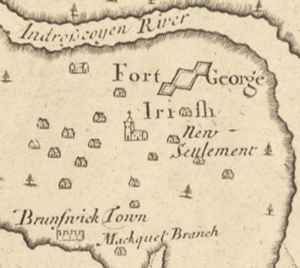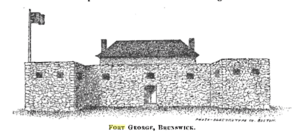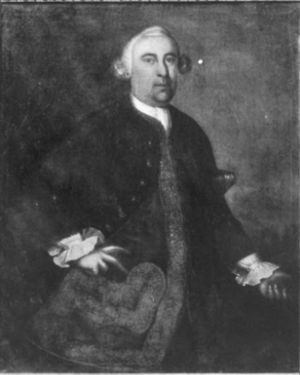Fort George (Brunswick, Maine) facts for kids
Fort George was an old British fort built between 1715 and 1737. It was located in a place called Pejepscot, which is now Brunswick, Maine. Back then, Maine was part of the Province of Massachusetts Bay, which was a British colony.
Contents
History of Fort George
Early Conflicts and Fort Building
Before Fort George, there was another fort here. In 1676, during a conflict called King Philip's War, the Wabanaki people destroyed a trading post. This post was near the Pejepscot Falls on the Androscoggin River.
Later, in 1688, Governor Edmund Andros built a fort near the falls. This was during King William's War. The fort was meant to stop the Wabanaki from fishing or moving their canoes there. However, this first fort was soon left empty and destroyed in 1689. This happened because of big changes in the government in New England.
In 1690, Major Benjamin Church led an expedition up the Androscoggin River. His group attacked a native village. They took some prisoners. A few days later, the Wabanaki attacked Church's men at Cape Elizabeth.
Building Fort George
After another conflict called Queen Anne's War, the British decided to build a new fort. This was Fort George. Captain John Gyles oversaw its construction in Brunswick in 1715.
The fort had strong walls. They were about 3 feet (0.9 meters) thick at the bottom. The walls stood at least 10 feet (3 meters) high above the ground. They were built with lime mortar. Inside, there were barracks for about fifteen soldiers. A large two-story house also stood within the fort walls. The fort's cannons could protect the buildings inside.
Life at the Fort During Wartime
During a conflict known as Father Rale's War (starting in 1722), Fort George became a safe place. People from Brunswick would gather inside the fort for protection. The fort often had to welcome many people. This was because attacks from Native American groups were constant. The fort was even under a siege during the early part of Father Rale's War.

In 1725, Captain William Woodside took charge of Fort George. Captain Gyles moved to another fort. Later, in 1730, Rev. Benjamin Kent became the minister for the area.
Dismantling the Fort
In 1736, the government of Massachusetts decided to take down Fort George. This decision would leave the town unprotected from attacks. The people of Brunswick and nearby Topsham were very worried. They sent a special request to Governor Jonathan Belcher of Massachusetts. They begged him to keep the fort.
A petition was signed by many families in April 1737. But their pleas did not work. The government decided to dismantle the fort anyway. The order was put into action right away. The land and buildings went back to their original owners.
Later Years and Ruins
During the French and Indian War, the land where the fort stood was divided. This happened in 1761. The fort and its buildings were given to Jeremiah Moulton and Captain David Dunning.
The old ruins of Fort George could still be seen until 1802.
Commanding Officers
Here are some of the people who were in charge of Fort George:
- Captain John Gyles, from 1715 to 1725
- William Woodside, in 1725
- Captain Jabez Bradbury, who also commanded Fort Richmond (Maine)
- Rev. Benjamin Kent, in 1730



